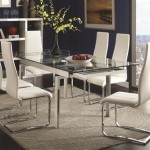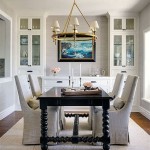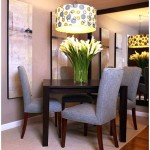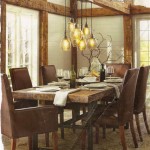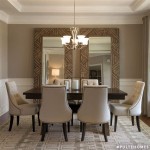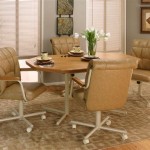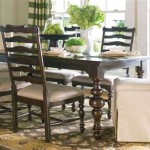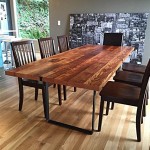Oak Express Dining Room Tables: A Comprehensive Overview
Oak express dining room tables represent a category of furniture focusing on the combination of oak wood's durability and aesthetic appeal with efficient production and delivery processes. These tables cater to individuals and families seeking a blend of quality, style, and relatively quick acquisition for their dining spaces. Understanding the nuances of oak express dining room tables requires consideration of materials, construction, design variations, and the factors contributing to their express nature.
Oak Wood: Properties and Variations
Oak, a hardwood derived from oak trees, is prized for its strength, resistance to wear, and distinct grain patterns. Two primary types of oak are commonly used in furniture construction: red oak and white oak. Red oak, characterized by its reddish hue and more porous structure, is generally more affordable and easier to stain. White oak, distinguished by its tighter grain and higher resistance to moisture, is often preferred for outdoor applications and high-end furniture. The choice between red and white oak influences the table's aesthetic and functional properties.
The durability of oak ensures that dining room tables constructed from this wood can withstand the rigors of daily use. Oak's inherent hardness makes it resistant to dents and scratches, contributing to the table's longevity. However, like all hardwoods, oak is susceptible to changes in humidity, which can lead to expansion and contraction. Proper sealing and finishing are crucial to mitigate these effects and maintain the table's integrity.
Beyond the basic distinction between red and white oak, various grades and cuts of oak lumber are available. Higher grades typically exhibit fewer knots and imperfections, resulting in a cleaner, more uniform appearance. The cut of the wood, such as plain sawn, quarter sawn, or rift sawn, affects the grain pattern and stability of the lumber. Quarter sawn and rift sawn oak are generally more stable and exhibit more visually appealing grain patterns, but they are also more expensive.
Construction Methods and Design Considerations
The construction of an oak express dining room table significantly impacts its strength, stability, and aesthetic appeal. Several joinery techniques are commonly employed, including mortise and tenon joints, dovetail joints, and screw-and-glue construction. Mortise and tenon joints, where a projecting tenon fits snugly into a mortise (hole), are renowned for their strength and durability. Dovetail joints, characterized by interlocking, wedge-shaped projections, are often used in drawer construction and other areas requiring high tensile strength. Screw-and-glue construction is a more cost-effective method, but its long-term durability may be less than that of traditional joinery techniques.
Tabletop construction can involve solid oak planks, oak veneers over a core material (such as plywood or MDF), or a combination of both. Solid oak tabletops offer the most authentic appearance and feel, but they are also the most susceptible to warping and cracking due to changes in humidity. Veneered tabletops provide a more stable and cost-effective alternative, although the quality of the veneer and the core material are crucial factors in determining the table's overall durability.
Design considerations encompass a wide range of stylistic elements, including the table's shape, size, leg design, and finish. Oak express dining room tables are available in various shapes, such as rectangular, square, round, and oval. The choice of shape depends on the size and configuration of the dining space, as well as the desired aesthetic. Leg designs range from simple straight legs to more elaborate turned or carved legs. The finish applied to the oak can range from natural oil finishes that accentuate the wood's grain to stained or painted finishes that alter its color and appearance.
The "Express" Factor: Efficiency and Availability
The "express" aspect of these dining room tables refers to the emphasis on efficient production and rapid delivery. This often involves streamlined manufacturing processes, standardized designs, and readily available materials. Manufacturers employing express production methods may utilize automated machinery, modular construction techniques, and lean inventory management to reduce production time and costs.
The availability of oak express dining room tables is often facilitated by online retailers and furniture stores that offer a wide selection of pre-designed and pre-fabricated tables. These tables are typically stocked in warehouses and can be shipped to customers within a relatively short timeframe. This contrasts with custom-made or bespoke dining room tables, which require longer lead times for design, fabrication, and delivery.
The trade-off for the convenience of express delivery may involve a limited selection of customization options. While some manufacturers offer variations in size, finish, or leg design, the overall design and construction of the table are typically standardized. Consumers seeking highly personalized dining room tables may need to consider custom-made options, which offer greater flexibility but require more time and investment.
Factors contributing to the efficiency of the "express" process include: 1.
Standardized Components:
Utilizing pre-cut and pre-finished oak components reduces manufacturing time. 2.Assembly Line Production:
Employing assembly line techniques ensures consistent and rapid construction. 3.Inventory Management:
Maintaining a sufficient stock of popular models allows for immediate order fulfillment. 4.Efficient Logistics:
Partnering with reliable shipping companies ensures timely delivery to customers.Finishes and Maintenance
The finish applied to an oak express dining room table plays a crucial role in protecting the wood from moisture, stains, and scratches, while also enhancing its aesthetic appeal. Common finishes include oil finishes, lacquer finishes, varnish finishes, and polyurethane finishes. Oil finishes penetrate the wood and provide a natural look and feel, but they require regular maintenance and offer limited protection against stains. Lacquer finishes create a hard, durable surface that is resistant to scratches and stains, but they can be susceptible to chipping and cracking. Varnish finishes offer a good balance of durability and aesthetic appeal, but they can yellow over time. Polyurethane finishes are the most durable and water-resistant option, but they can also appear artificial.
Proper maintenance is essential to preserve the beauty and longevity of an oak express dining room table. Regular cleaning with a soft, damp cloth is recommended to remove dust and dirt. Spills should be wiped up immediately to prevent staining. Avoid using harsh chemicals or abrasive cleaners, as they can damage the finish. Periodically applying a furniture polish or wax can help to protect the finish and enhance its luster.
To minimize the risk of damage from changes in humidity, it is advisable to maintain a relatively stable humidity level in the dining room. Using a humidifier or dehumidifier can help to regulate humidity levels. Avoid placing the table near sources of heat or moisture, such as radiators or humidifiers, as this can exacerbate the effects of humidity changes.
Cost Considerations and Value Proposition
The cost of an oak express dining room table depends on factors such as the type of oak used, the construction methods employed, the design complexity, and the brand reputation. Solid oak tables typically command a higher price than veneered tables. Tables constructed with traditional joinery techniques, such as mortise and tenon joints, are generally more expensive than those assembled with screws and glue. Elaborate designs and intricate carvings also contribute to higher costs.
The value proposition of oak express dining room tables lies in their combination of quality, style, and affordability. While they may not offer the same level of customization as custom-made tables, they provide a practical and aesthetically pleasing solution for individuals and families seeking a durable and attractive dining table without a long wait time. The durability of oak ensures that the table will withstand the rigors of daily use, while the variety of designs available allows consumers to find a table that complements their existing décor.
Consumers should carefully consider their budget, aesthetic preferences, and functional requirements when selecting an oak express dining room table. Reading online reviews and comparing prices from different retailers can help to ensure that they are making an informed decision. It is also advisable to inspect the table carefully upon delivery to ensure that it meets their expectations and that there are no defects in materials or workmanship.
Styles and Trends in Oak Dining Tables
Oak dining tables, even within the "express" category, encompass a wide array of styles to suit various design preferences. From rustic and farmhouse styles that emphasize the natural grain and character of the wood to more contemporary and minimalist designs that feature clean lines and sleek finishes, the options are abundant. The trends in oak dining tables often reflect broader trends in interior design, such as the increasing popularity of natural materials, sustainable practices, and personalized spaces.
Farmhouse style oak tables often feature distressed finishes, turned legs, and planked tops, evoking a sense of rustic charm and authenticity. These tables are typically larger and more substantial, suitable for accommodating large gatherings. Contemporary oak tables, on the other hand, tend to be more streamlined and minimalist, with clean lines, simple legs, and smooth finishes. These tables are often paired with modern chairs and minimalist décor.
Mid-century modern oak tables, inspired by the design aesthetic of the 1950s and 1960s, feature tapered legs, rounded edges, and a focus on functionality and simplicity. These tables are often smaller and more compact, suitable for smaller dining spaces. Industrial style oak tables combine oak with metal accents, such as steel legs or metal banding, creating a rugged and utilitarian aesthetic. These tables are often paired with industrial-style chairs and exposed brick or concrete walls.
The ongoing trend towards sustainability has also influenced the design and production of oak express dining room tables. Many manufacturers are now using sustainably sourced oak lumber and employing eco-friendly finishing techniques. Consumers are increasingly seeking furniture that is not only aesthetically pleasing but also environmentally responsible.

Oak Dining Table The Ultimate Buying Guide Furniture Outlet

Oak Furniture Dining Tables Countryside Amish

Oak Clearance Dining Sets

Oak Dining Furniture Painted Country Ways

Oakdale Oak Extending Dining Table 1 25m The Outlet Co

Oak Dining Table Sets For Modern Homes Furniture Outlet

Seattle Large Dining Table Oak Furniture Store Sofas
-700x700.jpg?strip=all)
Oak Dining Tables Avon Fixed Top Table 120 X 80 Pine And Shop

Casa Padrino Solid Wood Dining Room Set Natural Oak Table With 2 Benches Furniture Restaurant Rustic

How To Use Hardwick Light Oak Furniture Furnish And Open Plan Area

